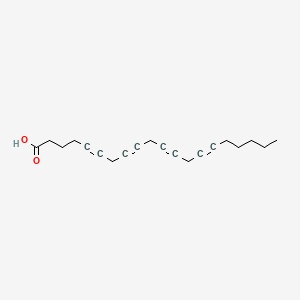| Lee KC et al. |
Novel effects of 5,8,11-eicosatriynoic acid, a lipoxygenase inhibitor, on Ca2+ mobilization in Madin Darby canine kidney cells. |
2001 |
Pharmacol. Toxicol. |
pmid:11169157
|
| Jeyaseelan S et al. |
Pasteurella (Mannheimia) haemolytica leukotoxin-induced cytolysis of bovine leukocytes: role of arachidonic acid and its regulation. |
2001 |
Microb. Pathog. |
pmid:11162186
|
| Fiorio Pla A and Munaron L |
Calcium influx, arachidonic acid,and control of endothelial cell proliferation. |
2001 |
Cell Calcium |
pmid:11587547
|
| Bautista R et al. |
Angiotensin II type AT(2) receptor mRNA expression and renal vasodilatation are increased in renal failure. |
2001 |
Hypertension |
pmid:11566953
|
| Kurebayashi S et al. |
TNF-alpha inhibits 3T3-L1 adipocyte differentiation without downregulating the expression of C/EBPbeta and delta. |
2001 |
Endocr. J. |
pmid:11456275
|
| Mouta Carreira C et al. |
The comparative release of FGF1 by hypoxia and temperature stress. |
2001 |
Growth Factors |
pmid:11519826
|
| Craib SJ et al. |
A possible role of lipoxygenase in the activation of vanilloid receptors by anandamide in the guinea-pig bronchus. |
2001 |
Br. J. Pharmacol. |
pmid:11522594
|
| Herbertsson H and Bengtsson T |
Role of platelets and the arachidonic acid pathway in the regulation of neutrophil oxidase activity. |
2001 |
Scand. J. Clin. Lab. Invest. |
pmid:11768324
|
| Worrell RT et al. |
Contrasting effects of cPLA2 on epithelial Na+ transport. |
2001 |
Am. J. Physiol., Cell Physiol. |
pmid:11401837
|
| Park Y and Pariza MW |
Lipoxygenase inhibitors inhibit heparin-releasable lipoprotein lipase activity in 3T3-L1 adipocytes and enhance body fat reduction in mice by conjugated linoleic acid. |
2001 |
Biochim. Biophys. Acta |
pmid:11750884
|
| Pomposiello SI et al. |
Epoxyeicosatrienoic acid-mediated renal vasodilation to arachidonic acid is enhanced in SHR. |
2001 |
Hypertension |
pmid:11244013
|
| Bruun JM et al. |
Interleukin-8 production in human adipose tissue. inhibitory effects of anti-diabetic compounds, the thiazolidinedione ciglitazone and the biguanide metformin. |
2000 Nov-Dec |
Horm. Metab. Res. |
pmid:11246821
|
| Li D et al. |
Arachidonic acid metabolic pathways regulating activity of renal Na(+)-K(+)-ATPase are age dependent. |
2000 |
Am. J. Physiol. Renal Physiol. |
pmid:10807595
|
| Hercule HC and Oyekan AO |
Cytochrome P450 omega/omega-1 hydroxylase-derived eicosanoids contribute to endothelin(A) and endothelin(B) receptor-mediated vasoconstriction to endothelin-1 in the rat preglomerular arteriole. |
2000 |
J. Pharmacol. Exp. Ther. |
pmid:10688635
|
| Tewari KP et al. |
PKA and arachidonic acid activation of human recombinant ClC-2 chloride channels. |
2000 |
Am. J. Physiol., Cell Physiol. |
pmid:10898715
|
| Maccarrone M et al. |
Anandamide induces apoptosis in human cells via vanilloid receptors. Evidence for a protective role of cannabinoid receptors. |
2000 |
J. Biol. Chem. |
pmid:10913156
|
| Wolfrum C et al. |
Binding of fatty acids and peroxisome proliferators to orthologous fatty acid binding proteins from human, murine, and bovine liver. |
2000 |
Biochemistry |
pmid:10684629
|
| Sciuto AM |
Posttreatment with ETYA protects against phosgene-induced lung injury by amplifying the glutathione to lipid peroxidation ratio. |
2000 |
Inhal Toxicol |
pmid:10715633
|
| Maccarrone M et al. |
Human mast cells take up and hydrolyze anandamide under the control of 5-lipoxygenase and do not express cannabinoid receptors. |
2000 |
FEBS Lett. |
pmid:10692582
|
| Casavant RH et al. |
Fatty acid-activated K+ channels in autonomic neurons: activation by an endogenous source of free fatty acids. |
2000 |
J. Neurochem. |
pmid:10693933
|
